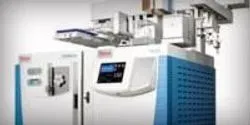Gas Chromatography

Using compressed gases in the laboratory can be dangerous if they are not handled properly. Many gases can be explosive, flammable, corrosive, and toxic. Because the gases are under high pressure in tanks and cylinders, any release of gas can spread quickly and endanger lab personnel—including the possibility of
death from explosion or asphyxiation. Less-deadly safety risks include physical injuries from mishandling tanks, especially to the hands, feet, and lower back.

Thermo Fisher Scientific has developed a simple, reliable and robust method for detecting dissolved gases in water using a gas chromatograph equipped with an autosampler and an electron flame ionization detector (FID).

The Pittcon 2015 Program Committee is pleased to announce the recipients of 14 prestigious awards honoring scientists who have made outstanding contributions to analytical chemistry and applied spectroscopy. Each award will be presented during a symposium at Pittcon 2015, March 8-12, 2015, New Orleans, Louisiana.

Chromatographers often need to balance the convenience of universal-use columns against the sensitivity and resolution of specialized columns. “Where labs may at one time have employed a nonpolar, all-purpose column, they now seek columns engineered for chemical families or even specific methods,” says Timothy Anderson, GC products manager at Phenomenex (Torrance, CA).

Derek Wachtel, scientist in the DMPK department at Ironwood Pharmaceuticals, and Mingliang Bao, PhD, senior scientist at Labstat International ULC, talk to contributing editor Tanuja Koppal, PhD, regarding various issues they face with sample prep in their laboratories. They both stress that sample prep is very important and a necessary step in any analysis and with newer technologies making it easier and faster to accomplish, there should be no reason to ignore or overlook it.

Problem: Research, QA/QC, and other laboratories ranging from large enterprise facilities to small analytical service centers are under increasing pressure to reduce costs and increase efficiency, productivity, and quality. To reduce operating costs, lab managers know they must find ways to speed turn-around and maximize throughput. To improve productivity and quality, it’s essential for them to easily access information that will allow them to efficiently staff the laboratory, allocate assets, and optimize workflows while adhering to strict quality standards and ensuring regulatory compliance.














